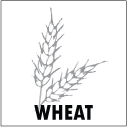
Gluten and Gliadin are the allergenic proteins present in Wheat grains.
- 3.6% American Adults are allergic to wheat proteins.
- 0.5% of 1-year-old children are allergic.
Wheat protein develops into two allergens for humans – Gluten and Gliadin.
Both can form Gluteomorphin, and both can resolve as Transglutaminase.
A gliadin allergy prohibits the consumption of not just gluten-containing wheat grains, but alternative grains that are gluten-free but high in gliadin. Quinoa is a non-gluten grain with a high level of gliadin.
Relevance to Food Service
- Gluten-free grains are still an allergen for those allergic to Gliadin proteins, as they occur is high amounts in these grains, such as quinoa, amaranth, millet, teff, sorghum.
- Gluten free is not wheat free.
- Awareness that Wheat allergy can be triggered by aeroallergens from grass (important for outdoors).
- Crumb cleanup is critical as Wheat allergy can be a potent contact allergen.
Celiac Disease
Is an autoimmune disorder (of the small intestine) that requires strict avoidance of gluten-containing grains.
Dietary Labeling for Wheat
All purpose (AP) Flour
Atta flour
Bran
Bread
Bread crumbs
Bulgar
Burghul
Cereal extract
Club wheat
Triticum compactum Host.
Common wheat
Triticum aestivum L.
Couscous
Cracker meal
Durum wheat
Triticum durum Desf.
Einkorn
Triticum monococcum L.
Emmer
Triticum turgidum L. subsp. dicoccon
Farina
Farro
Flour
Dietary Labeling for Wheat
Gluten
Graham flour
Kamut
Triticum polonicum L.; Khorasan
Malt
Matzo
Matzoh
Noodles
Pasta
Seitan
Semolina
Triticum durum Desf.
Soy sauce
Spelt
Triticum spelta L.
Stoneground Wheat
Tabbouleh/Tabouleh
Triticale
x Triticosecale ssp. Wittm.
Triticum
Wheat
Wheatgrass
Whole wheat berries
Most-likely contains Wheat
Baked goods
Baking mixes/powder
Battered fried foods
Beer
Biscuits
Breakfast cereals
Candies
Canned soups/stocks
Caramel color
Chips
Chocolate
Corn chips
Crumbed foods
Dextrin
Flavoring (natural/artificial)
Food starch
Gelatinized starch
Glucose syrup
Gravy
HVP
Hydrolyzed veg protein
Ice cream
Ice cream cones
Icing sugar
Instant drink mixes
Malted milk
Maltodextrin
Marshmallow
Modified food starch
Modified starch
MSG
Monosodium glutamate
Mustard
Noodles
Oats
Pancakes
Pasta
Pastry
Pizza
Processed meats
Sandwich wraps
Sauces/gravy mixes
Seitan
Snack foods
Soy sauce
Shoyu
Tamari
Teriyaki
Starch
Stock cubes
Surimi
TVP
Textured Veg protein
Vegetable gum
Vegetable starch
Allergenic Components in Wheat
Wheat contains several allergenic components, including:
- Gluten: This is the main allergen in wheat and is a mixture of proteins found in the endosperm of the wheat grain. It is responsible for the elastic texture of dough and is found in many baked goods, pasta, and other wheat-based foods.
- Albumins [scientific designation is Tri a 14]: These are water-soluble proteins that are found in the endosperm of the wheat grain. They are often heat-stable and can cause allergic reactions in some individuals.
- Globulins [scientific designation is Tri a 15]: These are proteins that are also found in the endosperm of the wheat grain and can cause allergic reactions in some individuals.
- Gliadins [scientific designation for gliadins is Alpha-gliadin (Tri a 19), Gamma-gliadin (Tri a 20), Omega-gliadin (Tri a 21), and Epsilon-gliadin (Tri a 22)]: These are alcohol-soluble proteins that are found in the endosperm of the wheat grain. They are often heat-stable and can cause allergic reactions in some individuals.
- Wheat Germ Agglutinin (WGA) [scientific designation is Triticum vulgaris lectin (TVL)]: This is a lectin that is found in the germ of the wheat grain and can cause allergic reactions in some individuals.
These designations are based on the systematic naming conventions used in the study of proteins and allergens, and are used by researchers to identify and study specific allergens in wheat and other grains. Understanding the specific allergenic components in wheat is important for the diagnosis and treatment of wheat allergies.